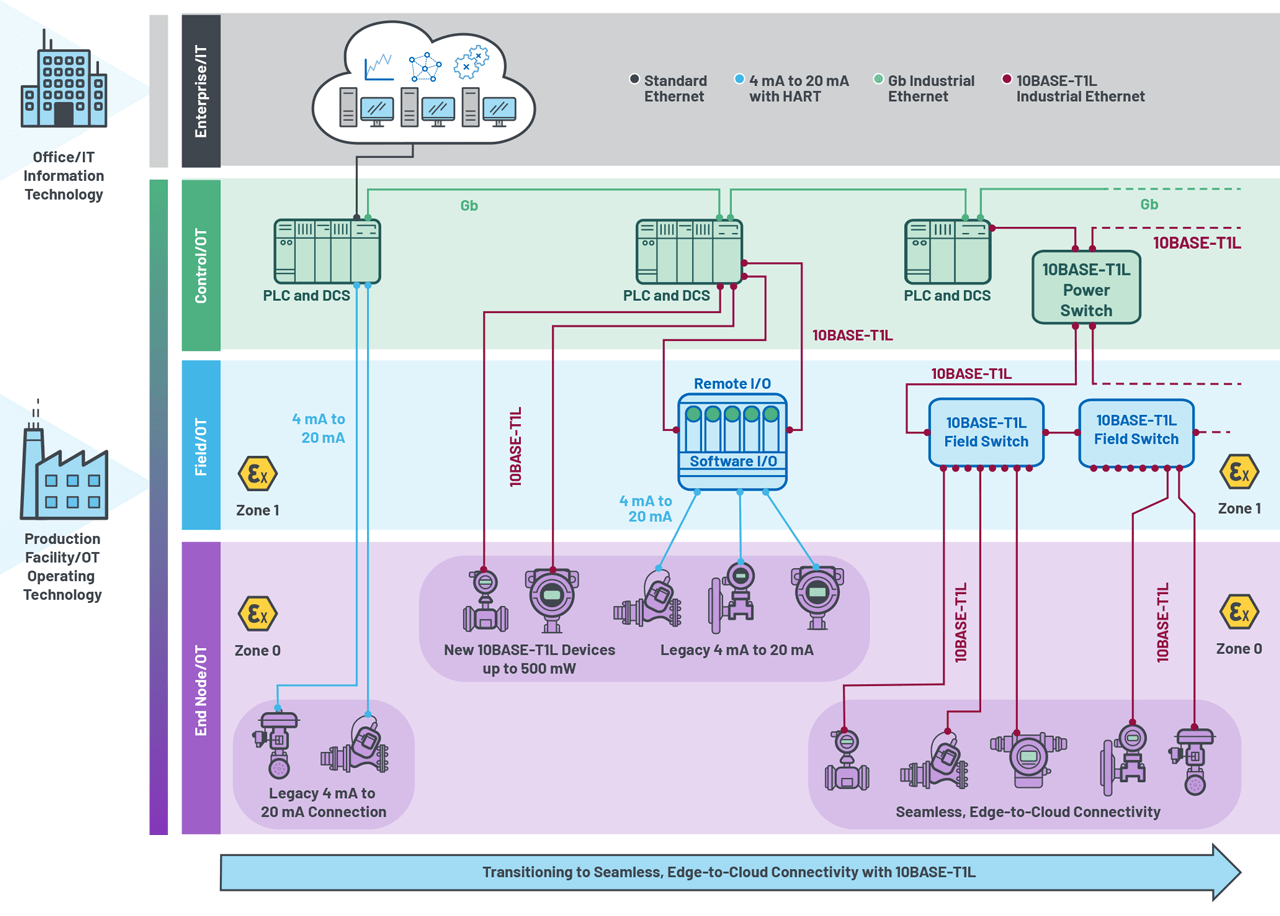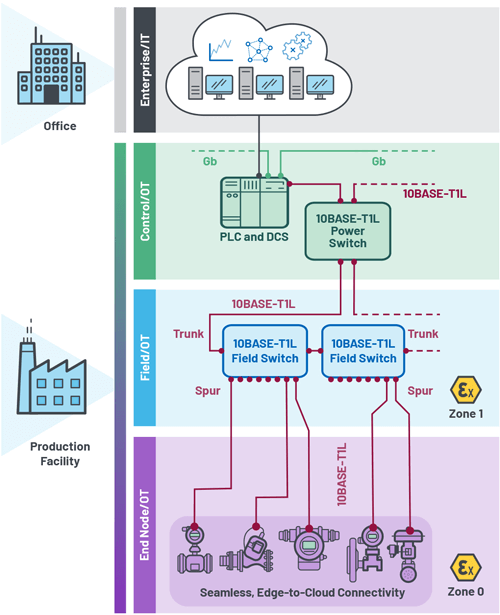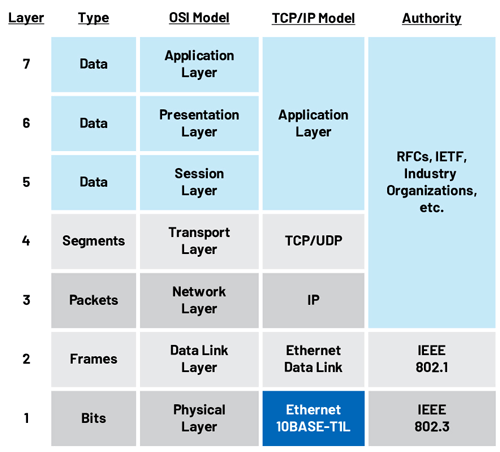TechnologyMarch 30, 2021
Seamless Ethernet to field devices in process automation

10BASE-T1L is a new Ethernet physical layer standard (IEEE 802.3cg-2019) that will dramatically change the process automation industry by significantly improving plant operational efficiency through seamless Ethernet connectivity to field-level devices (sensors and actuators).
10BASE-T1L solves the challenges that, to-date, have limited the use of Ethernet to the field in process automation. These challenges include power, bandwidth, cabling, distance, data islands, and intrinsically safe Zone 0 (hazardous areas) applications.
By solving these challenges for both brownfield upgrades and new greenfield installations, 10BASE-T1L will enable new insights that were previously unavailable, such as combining process variables, secondary parameters, asset health feedback, and seamlessly communicating them to the control layer and to the cloud. These new insights will awaken new possibilities for data analysis, operational insights, and productivity improvements through a converged Ethernet network from the field to the cloud.
To replace 4 mA to 20 mA or field bus communications (Foundation Fieldbus or PROFIBUS PA) with Ethernet in process automation applications, both power and data need to be provided to the sensors or actuators over a shielded single twisted pair cable. Single twisted pair cabling has the advantage of being lower cost, smaller size, and easier to install when compared to more complex cabling.
The distance between field-level devices in process automation applications has been a significant challenge with existing Industrial Ethernet physical layer technologies being limited to 100 m. With distances of up to 1 km required in process automation applications combined with the need for very low power and robust field devices suitable for use in Zone 0 (intrinsically safe) applications, a new approach to realize Ethernet physical layer technology for process automation was required. 10BASE-T1L is this new approach.
10BASE-T1L core capability is a full duplex, dc balanced, point-to-point communication scheme with PAM 3 modulation at a 7.5 MBd symbol rate with 4B3T coding. It supports two amplitude modes: 2.4 V peak-to-peak up to 1000 m cable and 1.0 V peak-to-peak at a reduced distance.

Legacy discrete wiring will gradually become a smart Ethernet network of all sensors and actuators.
The 1.0 V peak-to-peak amplitude mode means that this new physical layer technology can also be used in the environment of explosion-proof (Ex-proof) systems and meet the strict maximum energy restrictions. It enables long transmission distance on 2-wire technology with both power and data on a single twisted pair cable and it belongs to the family of single-pair Ethernet (SPE) media.
10BASE-T1L enables significantly higher power delivery to field devices; up to 500 mW in Zone 0 (intrinsically safe) applications. This is compared to approximately 36 mW with 4 mA to 20 mA devices. In non-intrinsically safe applications, up to 60 W of power is possible depending on the cable used. With significantly more power available at the edge of the network, new field devices with enhanced features and functions can be enabled because the power limitations of 4 mA to 20 mA and field bus no longer apply.

10BASE-T1L network topology for the process industry.
For example, higher performance measurement and enhanced edge processing of data is now possible with the additional power. This will unlock valuable insights about process variables that will now be made accessible via a web server running on the field-level devices (field assets), and which will ultimately drive improvements and optimizations in process flows and asset management.
To exploit the rich dataset containing these valuable new insights, a higher bandwidth communications link is required to deliver the dataset from the field devices across the process installation, to plant-level infrastructure or up to the cloud for processing. 10BASE-T1L removes the needs for complex, power hungry gateways, and enables a converged Ethernet network across the information technology (IT) and operating technology (OT) networks.
This converged network delivers a simplified installation, easy device replacement, faster network commissioning and configuration. This results in faster software updates with simplified root cause analysis and maintenance of field-level devices.
Ethernet-based solution
By converging on Ethernet as the method of communication across the enterprise, control- and field-level in process automation, the need for complex and power-hungry gateways has been removed. This also enables a transition from the hugely fragmented field bus infrastructure that has created data islands where access to the data within field-level devices is limited. By removing these gateways, the cost and complexity of these legacy installations is significantly reduced and the data islands they created are removed.

10BASE-T1L in the ISO 7-layer model.
Process automation applications, to-date, have used the legacy communications standards shown in the table, which have several limitations that the new 10BASE-T1L standard overcomes. There is also a knowledge base challenge within process automation. Through retirement, technicians and engineers are leaving the workforce and taking with them the detailed knowledge of how to deploy, debug, and maintain installations of 4 mA to 20 mA with HART or field bus communications systems. College graduates are not familiar with these legacy technologies, but are very familiar with Ethernet-based technology and can quickly ramp up Ethernet-based networking solutions.
Ethernet standards ensure that all higher protocol layers with 10BASE-T1L work exactly as with 10BASE-T, 100BASE-TX, and 1000BASE-T, eliminating the need for complex gateways. IEEE 802.3 is where all physical layers in the ISO 7-layer model are defined for Ethernet: 10BASE-T1L. This means that devices can now use the PROFINET, EtherNet/IP, HART/IP, OPC UATM, or MODBUS/TCP and support IoT protocols such as MQTT, which offers a simple yet powerful way to connect a field device to the cloud. Ethernet also enables simple, centrally controlled software updates right down to the end nodes, which enables faster network commissioning.
To communicate with a 10BASE-T1L enabled device, a host processor with integrated medium access control (MAC), a passive media converter, or a switch with 10BASE-T1L ports is required. No additional software, no customized TCP/IP stack, and no special drivers are required. This results in clear advantages for 10BASE-T1L devices.
Although a media converter is required for the connection of 10BASE-T1L, it only converts the physical encoding, not the content of the Ethernet packets. From the point of view of software and communication protocols, it is transparent.

Field-level device connectivity with a 10BASE-T1L PHY.
With Ethernet connectivity, it is possible to configure sensors with a laptop or mobile phone, regardless of whether the sensor is on the desk or is deployed in a manufacturing plant. For example, a temperature transmitter today has an additional interface (for example, in the form of USB), in order to be able to configure the converter. Depending on the manufacturer, there are well over 100 adjustment options.
These parameters are simply not accessible today via 4 mA to 20 mA. HART allows access but is often unavailable for cost reasons. So, if a mistake was made during setup at the desk, a 4 mA to 20 mA sensor would need to be reconfigured after installation on site. A sensor connected with 10BASE-T1L is accessible over the network and can be remotely updated anywhere, at any time.
- The 4 mA to 20 mA devices can only transfer one process value. Ethernet provides direct access not only to process values but to all device parameters such as asset management, life cycle management, predictive maintenance, configuration, and parameterization.
- Sensors are becoming more complex and the probability of software updates increases. This is now possible within realistic periods of time via a fast Ethernet connection, anywhere, anytime.
- Access to advanced Ethernet network diagnostic tools to simplify root cause analysis.
Process automation deployment
In process automation, unlike in machine building or factory automation, these sensors and actuators (flow, level, pressure, and temperature) do not sit close to the controller.
istances of 200 m between sensors and I/O are not uncommon and from there it can be up to 1000 m between field switches. Process automation uses a Type A field bus cable, as it is already used for PROFIBUS PA and Foundation Fieldbus installations today.
The 10BASE-T1L standard does not define a specific transmission medium (cable); instead, it defines a channel model (return loss and insertion loss requirements). The 10BASE-T1L channel model fits well with a field bus type A cable, therefore some installed 4 mA to 20 mA cables can potentially be reused with 10BASE-T1L, creating significant opportunities for brownfield upgrades of process automation installations.
As 10BASE-T1L allows the signal amplitude voltage to be reduced to 1 V on lines of up to approximately 200 m, 10BASE-T1L can be used in the environment of explosion-proof systems and meet the strict maximum energy restrictions of hazardous areas with up to 500 mW of power.
With the significant increase in power compared to 4 mA to 20 mA (500 mW vs. ~36 mW), today’s 4-wire devices that require an external power supply due to the limited power of 4 mA to 20 mA can now be replaced with 2-wire devices enabled by 10BASE-T1L, providing more installation flexibility for new devices by removing the need for an external power supply.
The proposed network topology for the process industry is referred to as a trunk and spur network topology. The trunk cables can be up to 1 km with a PHY amplitude of 2.4 V peak-to-peak and reside in Zone 1, Division 2. The spur cables can be up to 200 m in length with a PHY amplitude of 1.0 V peak-to-peak and reside in Zone 0, Division 1. A power switch resides at the control level, provides Ethernet switch functionality, and supplies the power to the cable (over the data lines).
Field switches reside at the field level in the hazardous area and are powered by the cable. The field switches provide the Ethernet switch functionality that connects the field-level devices on the spurs to the trunk and pass the power to the field-level devices. Multiple field switches are connected on a trunk cable to provide for the high numbers of field-level devices to be connected to the network.
The field switches can be connected via a ring topology to enable redundancy. At the edge, up to 10 Mbps is a major advance for most applications previously limited to a data rate of less than 30 kbps. As Ethernet is now used to connect the end node devices at the field level, IT and OT have been converged onto a Ethernet network, enabling IP addressability to any end node device from anywhere.
Ethernet-APL with 10BASE-T1L
Ethernet-APL (advanced physical layer) specifies the details of the application of Ethernet communication to sensors and actuators for the process industry and will be published under the IEC. It is based on the 10BASE-T1L Ethernet physical layer standard and specifies the implementation and explosion protection methods for use in hazardous locations.
The leading companies in process automation are working together under the umbrella of PROFIBUS and PROFINET International (PI), ODVA, Inc., and FieldComm Group to make Ethernet-APL work across Industrial Ethernet protocols and to accelerate its deployment.
Future seamless connectivity
The 4 mA to 20 mA connection with HART has been successfully deployed in process automation applications for many years and is a proven, robust solution that will not disappear overnight.
There is a large, existing install base of 4 mA to 20 mA with HART-enabled instruments and Analog Devices is investing in software configurable I/O, which enables more installation flexibility for these existing devices by allowing any industrial I/O function to be accessed on any pin, allowing channels to be configured at any time in remote I/O applications.
This means customization can happen right at the time of installation, resulting in faster time to market, fewer design resources, and universal products that can be leveraged broadly across projects and customers. Examples of software programmable I/O circuits from Analog Devices are the AD74413 and the AD4110-1.
The transition from legacy 4 mA to 20 mA connected instruments to a brownfield Ethernet means that new 10BASE-T1L-enabled instruments will coexist with legacy 4 mA to 20 mA instruments. Software configurable I/O connects these legacy instruments where remote I/O provide the aggregation point to a 10 Mb Ethernet uplink to the PLC.
Seamless, edge-to-cloud connectivity will be achieved in process automation with 10BASE-T1L technology. 10BASE-T1L removes the need for gateways and I/O, as well as enables Ethernet connectivity from the field devices to the control level and eventually to the cloud. Unlocking field devices will result in rich datasets for advanced data analytics.
Applications beyond process
10BASE-T1L is now gaining significant traction in building automation, factory automation, energy supply, monitoring, automation of waterworks and wastewater treatment, and, finally, elevators. All these applications share the requirements for higher bandwidth, seamless Ethernet connectivity (no gateways) to the sensor, on a single twisted pair cable supporting both power and data. Table 2 compares 10BASE-T1L with the incumbent wired technologies used today. Application examples include RS-485 used in building automation and I/O link used in factory automation.
Drive process optimization
With the addition of 10BASE-T1L physical layer products to Analog Devices’ Chronous portfolio of Industrial Ethernet solutions, ADI will enable the transition to field-to-cloud connected process automation installations, including hazardous locations for food and beverage, pharmaceutical, and oil and gas installations. New 10BASE-T1L physical layer transceivers will provide the physical layer interface to unlock the many advantages of an Ethernet connected plant.
With 10BASE-T1L, Ethernet packets move from the field level to the control level, and eventually to the cloud, without gateways, realizing the goals of an Industrial 4.0 unified IT/OT network.
With significantly more power available, new types of field devices with enhanced features and functions can be enabled. Transparent IP addressability of each field-level device will dramatically simplify the installation, configuration, and maintenance of 10BASE-T1L connected instruments.
10BASE-T1L will unlock field devices, rich datasets for cloud computing, and advanced data analytics. Plant operational efficiency will be increased through the access of actionable insights from their processes, accelerating the deployment of more complex process automation production facilities in the future.


